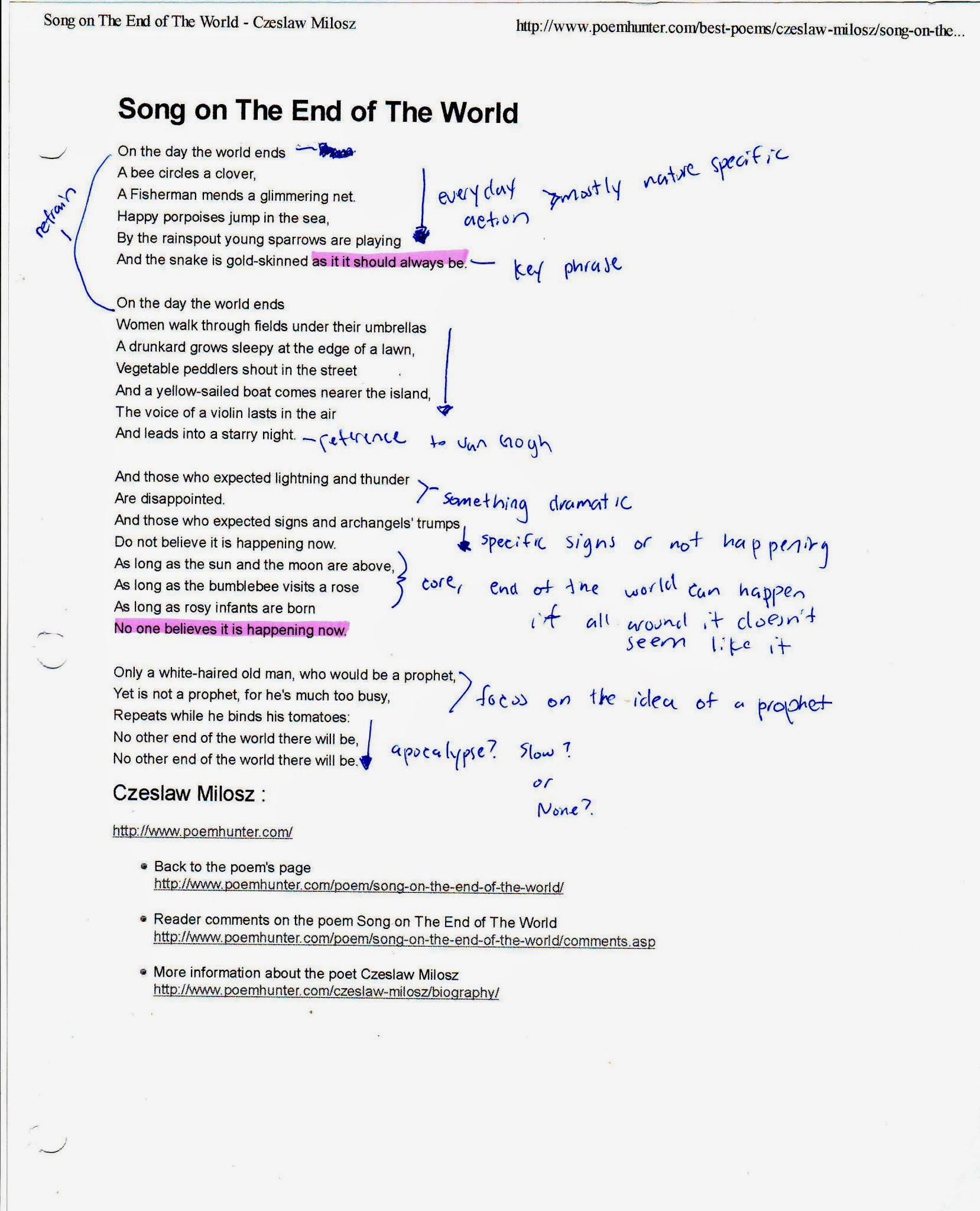Original poem reprinted online here: "Song on The End of the World" by Czeslaw Milosz
Originally read: November 12, 2013
More information about the Poet: Czeslaw Milosz
So this poem is more of a cause and effect type of poem. The cause and the effect is not about "the end of the world" though. This poem plays with perceptions.
There's no set stanza structure or order which is important in this poem because there's nothing to predict through the structure like the first two lines, "On the day the world ends, / A bee circles a clover," and then starts the list of the ordinary, but not mundane:
Originally read: November 12, 2013
More information about the Poet: Czeslaw Milosz
So this poem is more of a cause and effect type of poem. The cause and the effect is not about "the end of the world" though. This poem plays with perceptions.
There's no set stanza structure or order which is important in this poem because there's nothing to predict through the structure like the first two lines, "On the day the world ends, / A bee circles a clover," and then starts the list of the ordinary, but not mundane:
- A fisherman mends a glimmering net
- Happy porpoises jump in the sea,
- By the rainspout young sparrows are playing
- And the snake is gold-skinned as it should always be
Note with this list, the focus is to the sea and then the land. This focus also brings in the actions of people and the actions of animals -- either they are unaware, or don't care. Actually, no. What the list shows is actions happening on the day and it is nothing dramatic like the next list (second stanza):
- Women walk through fields under umbrellas
- A drunkard grows sleepy at the edge of a lawn
- Vegetable peddlers shout in the street
- And a yellow-sailed boat comes nearer the island
- The voice of a a violin lasts in the air / and leads into a starry night
This list operates differently focusing on more of a urban landscape to the naturalistic. One big note is with number 2 with the introduction of the drunkard. The line adds a sense of humor to the poem. But other than that the scenes, like the first stanza, are more realistic actions done by humans or animals. However, with this stanza in particular the last image is a sonic one that goes expansive -- from the violin to the starry night (allusion to Van Gough -- just for the sake of allusion). In any case, there's a transition that continues image wise by not rhetoric wise.
"And those who expected lightning and thunder / are disappointed" Note that the specifics are to "those" looking up to the sky and seeing something portent. And with a more specific jab, "And those who expected signs and archangels' trumps / Do not believe it is happening now" at the divine. This poem isn't against religion (just yet), rather at "those" who seek a cataclysmic divine sign like angels and thunder to tell them the world is ending.
As long as the sun and the moon are above,
As long as the bumblebee visits a rose
As long as rosy infants are born
No one believes it is happening now
The anaphora of "As long as" plays with the idea of time and length, and also conditional priority -- as long as "x" exists then "no one believes it is happening now" The \key word being "believes" since the world could be ending, but around things seem pretty normal.
So the last stanza brings up a person, a would be a prophet but who "is not a prophet" -- the potential to state the future, but isn't claiming to be able to state the future "binds his tomatoes," something so innocuous (this is the action) while the thought (what is believed) is repeated, "No other end of the world there will be, / No other end of the world there will be."
So when I first read this, I thought, hey, no end of the word will happen. But upon further inspection, the phrase represents the whole idea: as long as regular and good things are happening, then no one believes in the end of the world"
To apply this idea, around me are normal things happening everyday, but somewhere else there could be someone's apocalypse, a world ending due to war or some "lightning and thunder" from the sky that we cannot see.
Or to put the idea more succinctly: does the end of the world happen if we don't experience it until it is too late?

Comments
Post a Comment